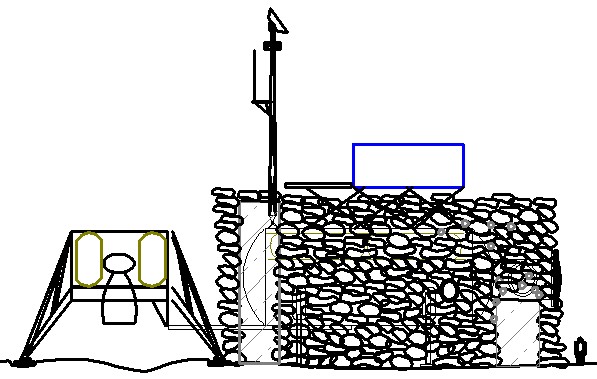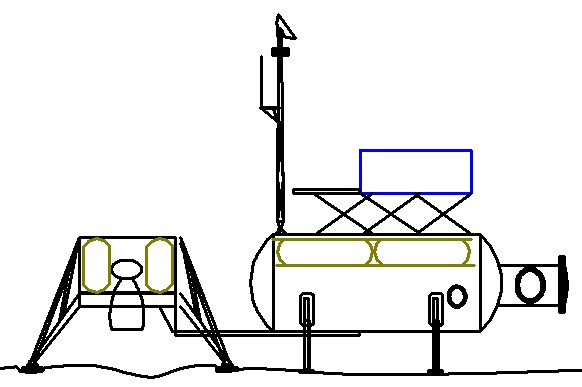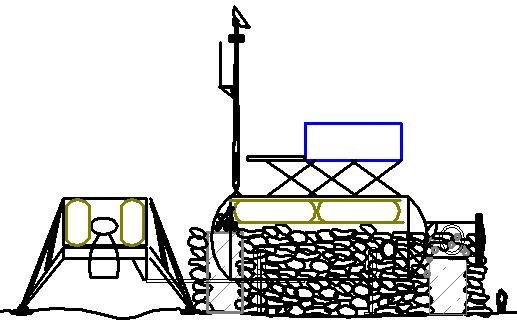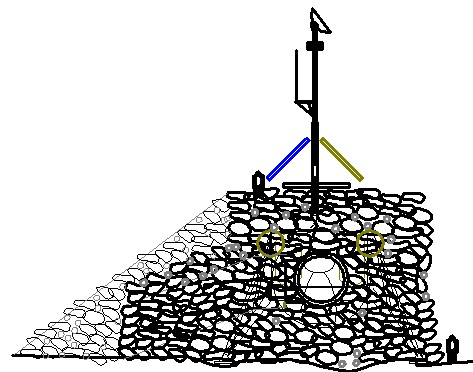Difference between revisions of "Architecture in Field Stone"
m |
|||
| Line 172: | Line 172: | ||
When the astronauts and lunar miners arrive some months later they will find a safe place to stay. A long list of work and problems will await them. | When the astronauts and lunar miners arrive some months later they will find a safe place to stay. A long list of work and problems will await them. | ||
| − | For launch any moveable internal parts inside the habitat will be firmly anchored at the rocket end. There will days of unpacking and setting up to do | + | For launch any moveable internal parts inside the habitat will be firmly anchored at the rocket end. Thsi will keep the center of gravity low. There will days of unpacking and setting up to do. |
| − | |||
| − | |||
| + | The radiation level inside the habitat will be monitored for the whole construction period. It is possible that it will be safe for the astronauts on the first floor when the wall is only 1/2 way up. | ||
==The Look of the Place== | ==The Look of the Place== | ||
Revision as of 06:26, 29 July 2007
Lunar Architecture
As Field Stone Constructions
A lunar outpost might turn out to look like nothing anybody ever envisioned.
Consider the following scenario:
What if we are required to build our very first lunar outpost habitat with full radiation and thermal shielding from the very first minute the astronauts set foot in it. (The safety people really can lay this type of requirement on you.)
Furthermore, we must use lunar mass to create this shielding as the cost of shipping it from Earth is way too high.
We could dig the outpost into the regolith, as shown in Architecture as Mole Hills, but this would require massive excavation equipment operated by remote from Earth. We will not have a backhoe and a bulldozer handy on the Moon. Besides we do not know how rocky the regolith is at depth and the opportunity for damage to the habitat would be very high.
What we do have is rocks. Lots and lots of rocks.
What we might be able to get to the Moon is a few golf cart sized pieces of construction equipment. None of them would be powerful enough to accidentally damage the habitat.
We might even get thousands of people on Earth to help us, Tom Sawyer style. That would really generate buy-in for the lunar settlement project.
In such a case, one small development, a good lunar mortar, could lead to a solution to our problem and in the process produce a totally unexpected vision of a lunar settlement.
Stages of the Field Stone Plan
This Field Stone Plan has a number of distinct stages carrying it from launch to moving in.
Exploration
The first step is a detailed orbital study of the site. The LRO data should be good for this requirement.
We then need a rover mission to check out the site insitu. This rover must have good vision and be able to run a wide variety of tests. In addition to science, it must measure commercially valuable data, like volatile availability, and take critical construction data, like the distribution of buried rocks.
It may be necessary to send rovers to several locations to be sure we have the optimal location for our outpost.
At some point we must commit to one location and go for it.
Establish Utilities
The next step, and the first major landing, is to establish basic utilities and site the construction rovers. This will take a dedicated flight of a new heavy lift vehicle, the Cargo Delivery Vehicle (CDV), which can carry both the fixed and mobile systems in one trip.
The fixed systems will include solar panels for power, thermal panels to reject waste heat, communications equipment for broad band to Earth, and a command and control box with real computer power.
Connected to these utilities will be small fixed processing facilities. One will generate water and oxygen from the magnetic component of the regolith. And one will make our magic lunar cement.
The mobile units will include:
- Dust Rover
- A rover capable of scooping up the top 6 centimeters of lunar regolith, which is a fine power, moving it, and dumping it.
- Mason rover
- A rover capable of picking up a building stone, even if mostly buried, moving the stone some distance, placing the stone on the top of a wall up to a meters above its head, dispensing mortar, and setting the stone. It must also accurately measure locations and inspect the job.
- Lunar Volatizes Harvester
- An engineering model of a Lunar Volatiles Harvester (LVH, see Volatiles Harvester Spec). Although only a fraction of the size of a full sized LVH, it still must dig regolith, sort the material by size, magnetically sort out one component, and cook out enough hydrogen and by-products out of the fines to keep the fixed processing facilities running. It will also be the test bed for future large LVH’s.
These rovers are all controlled largely from Earth, but can act independently to protect themselves.
Habitat Launch
The core of our habitat is designed to max out the capabilities of the Cargo Delivery Vehicle (CDV), both for mass and the size of its shroud. It will make a simple trip to the Moon without any rendezvous. This trip may be slow trip taking several weeks.
The habitat core will be basically a big cylinder stacked on top of a rocket base.
The habitat core cylinder with have:
- An airlock on the top end
- Lots of equipment bolted to the sides
- Landing struts along the bottom side
- A very few round port windows
- A large amount of critical equipment stored inside
The typical dimensions chosen for this example are:
- Length – 16 meters (52 ft)
- Diameter - 6.7 meters (22 ft)
This is large enough to have two living floors.
To get the habitat core to the Moon, the rocket base must execute:
- Lunar insertion burn
- Mid-transit correction burn
- Decent burn
- Throttled landing
- Vernier thruster pointing control including at least two high on habitat cylinder
After the habitat is in place, the rocket section has no father use and can be scavenged for parts and materials. It never leaves the Moon again.
Landing
The entire rocket and habitat must land robotically standing on its end and looking like a wine bottle. This is the only configuration allowed by the launch shroud and there is no good reason to change the configuration on the way to the Moon.
The landing site must be near the mobile vehicles and utilities, but must not be right on top of them.
As soon as the landing dust settles, the communications mast that is stored on the side of the cylinder, swings out to 45 degrees and the disk seeks out the Earth.
Tip-Down
The Dust Rover and Mason Rover will then prepare the tip-down site. They will remove the top dust layer and any surface rocks. This will leave a solid packed regolith foundation for the habitat core.
The main cylinder then unlatches from rocket section and swings down to the surface on a long hinge strut. The high vernier thrusters fire both to start and to break its fall.
The communication mast then opens to straight up. Now on top of the cylinder, the solar panels, thermal panels, and instrument pallet raise to 2.5 meters above the cylinder wall.
The habitat core also kneels, or lowers itself on its struts. This places its bottom as close to the ground as practical.
Wall Construction
Now it is time for our Magic Lunar Cement (see Industrial Mechanisms). We must assume that we have a good product at this point or the project would simply not get this far.
All the masonry work will be done by robotic controlled from Earth. The process will take months and could involve thousands of volunteers.
The main point of this whole design is to get a very large number of Earth people from all over the world involved in the construction. There will be remote stations at schools and science centers that allow control of the robots.
The task is to select a good position for a stone, fetch a stone that will fit, dispense the cement, set the stone, and inspect the work. With nearly a two second round trip delay each step will be difficult and the robot’s software will have to be flawless.
It will also be necessary to organize stone expeditions to build up a supply of stones. Some will come from site clearing, others from the LVH path, but many will simply have to be fetched from the surrounding fields.
Filling In
The rock wall is really only a retaining wall. The space between the rock wall and the habitat wall will be filled with regolith from which all sharp rocks have been removed. The Dust Rover will have to place this material and pack it with a vibrating rod.
This approach requires that the wall and fill area be wide enough, at their narrowest, to serve as a work platform for the robots.
The top of the wall must be high enough to allow for two meters of packed regolith over the top of the habitat core. Any solar panels and other equipment on the roof will need to be on extended frames to get them above this shield.
Special Features
One end of the building will need a Pharos’s ramp. This is two long walls extended from the side of the building and the space between packed with regolith. It forms a ramp with a low enough slop, about 30 degrees, for the robots to roll up. By the end of the construction it will be quite long.
There will be a stone arch walk way up to the airlock door. This will include a sloped walkway up to the height of the door sill. This arched walk way must be long enough that there is no straight path for radiation to get to the airlock.
Arches will also be needed over the few windows. The windows will then be set deep in the walls.
The exposed end of the airlock is designed to allow connection with later habitat sections. At this time it will half to be covered with a large pile of regolith.
Moving In
When the astronauts and lunar miners arrive some months later they will find a safe place to stay. A long list of work and problems will await them.
For launch any moveable internal parts inside the habitat will be firmly anchored at the rocket end. Thsi will keep the center of gravity low. There will days of unpacking and setting up to do.
The radiation level inside the habitat will be monitored for the whole construction period. It is possible that it will be safe for the astronauts on the first floor when the wall is only 1/2 way up.
The Look of the Place
But what about the look of the place or, its curb appeal.
It will look truly massive. More like a pre-Columbian pyramid than space habitat. The size will be about:
- Length – 22 meters (72 ft)
- Width – 11 meters (36 ft)
- Height – 8.7 meters (32 ft)
- Pharos’s ramp at 30 degrees – 15 meters (50 ft)
The walls look massive, more like a castle than a house. It will be positively spooky at night when seen by Earth light.
Challenges
We do not yet have a good lunar cement formula and that is probably the least of our worries. Almost certainly at least part of the cement will have to be shipped from Earth and that will likely amount to tons of materials. There are simpler ways to shield a habitat with these levels of resources.
Equipment can break down and be very difficult to repair or replace. We could easily wear out several sets of rovers.
The rover software would have to be absolutely fool proof. We are calling for a device the size of a golf cart working on a ledge only a little wider and hefting massive stones around. And working under the remote direction of an incompetent to boot.
It will take many months to do the stone work. Planning the manned flight for its completion will be difficult.
The involvement the world could be a really big boom or a really big bust. If it works, it we will be back to the glory days of Apollo to the Moon. If it fails, we will simply have to retire to the back rooms and do the masonry work ourselves.
Conclusion
We need to learn to think Moon. The ideas we formed in a lifetime living on Earth may not serve us well on the Moon.
Now is the time to get raw ideas out there.
____











